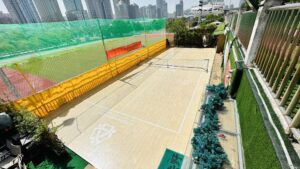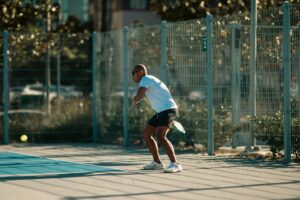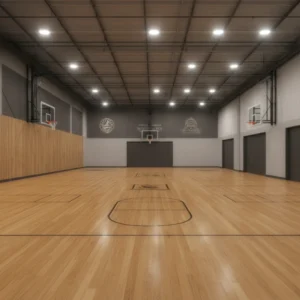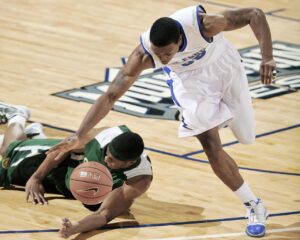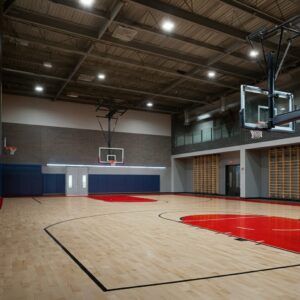Imagine stepping onto your very own home basketball court. Whether you’re shooting hoops with friends or practicing drills with your kids, having the right court flooring can elevate your game and ensure safety and performance. Choosing the best flooring option can be challenging, but it’s critical for creating a court that’s durable, comfortable, and visually appealing.
This guide dives deep into the best indoor basketball court flooring options, comparing their pros and cons, highlighting top-rated brands, and offering tips on maintenance and cost-saving alternatives. By the end, you’ll know exactly which surface is right for your home basketball court.
Why Flooring Matters for Home Basketball Courts
When it comes to creating an indoor sports space, the choice of flooring is a decision you can’t overlook.
1. Safety Comes First
Shock absorption is vital in preventing injuries while playing basketball, especially on a home court. Proper flooring minimizes stress on joints and reduces the risk of impact-related injuries, making it ideal for players of all ages.
2. Performance Enhancement
The right flooring impacts how the ball bounces, a crucial factor for smooth gameplay. Surfaces like hardwood and synthetic floors are designed for consistent bounce and controlled movement.
3. Durability
Home basketball courts endure heavy foot traffic and constant wear and tear, so choosing long-lasting flooring is critical to maintain usability and aesthetic appeal.
4. Ease of Maintenance
With busy schedules, you want a floor that’s easy to clean and maintain. From scuff marks to dust, basketball court surfaces should stay functional and visually appealing with little effort.
Types of Flooring Options for Home Basketball Courts
When choosing your home court surface, some key materials consistently stand out. Here’s what you need to know about hardwood, synthetic, and rubber flooring.
1. Hardwood Flooring
A favorite among basketball pros, hardwood is the gold standard for an authentic playing experience.
Pros:
- Classic visual appeal with a premium finish
- Provides excellent ball bounce and smooth gameplay
Cons:
- Expensive to install and maintain
- Less shock absorption compared to synthetic alternatives
- Susceptible to moisture damage
Hardwood flooring options like CopoSports Biomass Sport Wooden Flooring combine elegance with performance, making them perfect for indoor courts.
2. Synthetic Flooring
Synthetic basketball court flooring is a versatile and modern solution, often used in both professional venues and home setups.
Pros:
- Superior shock absorption to protect joints
- Low maintenance and easy to clean
- Available in various textures and colors
Cons:
- May not have the premium look of hardwood
- Surface wear can appear over time with heavy use
Brands like CopoSports Interlocking Flooring create modular synthetic panels that are easy to install and tailor to your space. Plus, synthetic surfaces often hold certifications like FIBA approval, ensuring professional-grade performance.
3. Rubber Flooring
For multi-purpose home gyms that double as basketball courts, rubber flooring offers a durable and budget-friendly option.
Pros:
- Affordable and easy to install
- Great for multi-sport or gym use
- Shock-absorbing and slip-resistant
Cons:
- Lacks the professional aesthetic of hardwood
- Not ideal for serious basketball enthusiasts due to lower ball responsiveness
Rubber floors excel in versatile spaces but may not meet the expectations of those aiming for a professional-court feel.
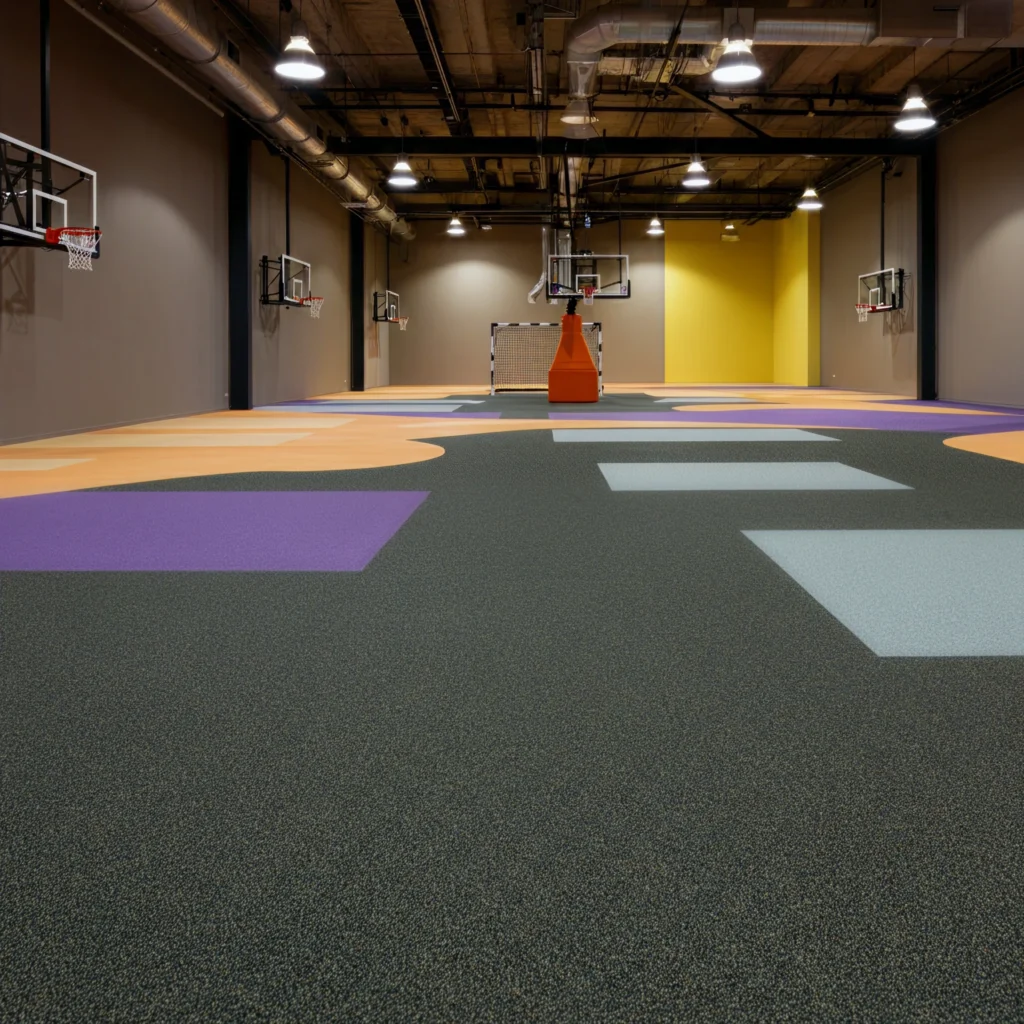
Detailed Comparison of Home Basketball Court Flooring
Now that we’ve looked at the main types of surfaces, how do they stack up to each other? Here’s a side-by-side comparison:
1. Shock Absorption
- Synthetic flooring offers the best shock absorption, reducing stress on joints.
- Rubber flooring also scores high on impact minimization.
- Hardwood flooring lags slightly, as it’s less forgiving when absorbing force.
2. Maintenance
- Synthetic flooring and rubber flooring require minimal upkeep and are resistant to spills or dust.
- Hardwood flooring demands regular polishing and occasional repairs to maintain its premium look.
3. Cost
- Rubber flooring is the most affordable, followed by synthetic options.
- Hardwood flooring is the priciest, considering upfront installation and long-term upkeep.
4. Aesthetics
- Hardwood flooring steals the show with its timeless, premium appearance.
- Synthetic flooring can imitate hardwood at a lower cost while offering a variety of finishes.
- Rubber flooring is practical but lacks visual appeal for dedicated basketball courts.
Brands and Products with High Customer Ratings
To help make your decision easier, here’s a curated list of top-rated brands for basketball court surfaces:
Hardwood
- CopoSports Biomass Sport Wooden Flooring
Offers premium aesthetics and professional-grade performance with FIBA certification.
Synthetic
- CopoSports Interlocking Flooring
Perfect for quick installations, this modular system is praised for its durability and ease of use.
Outdoor Risks
- For external-use basketball courts that rival major global tournaments, Coposport emerges unbeatable. `
Rubber
- RubberGym Flooring Solutions
Durable, cost-effective, and ideal for multi-sport uses and kids’ play areas.
Maintenance and Long-Term Care Tips
To protect your investment, proper care is essential. Here’s how you can extend the lifespan of your basketball court flooring:
- Hardwood: Regularly clean with a microfiber mop and avoid excessive moisture. Sand and reseal the surface every few years.
- Synthetic: Use a mild cleaner and a soft mop to remove dirt. Avoid dragging heavy furniture or equipment across the surface.
- Rubber: Sweep regularly to remove dust and mop with water-based cleaning solutions.
Cost Considerations and Budget-Friendly Alternatives
If you’re working within a budget, synthetic and rubber options offer excellent value without sacrificing much in terms of performance. Modular products like CopoSports Interlocking Flooring are also great for DIY installations, saving money on professional labor.
Choosing the Perfect Flooring for Your Home Basketball Court
The choice of flooring depends on your priorities, whether it’s creating a professional-grade basketball court or a versatile space for family activities. If you prioritize aesthetics and performance, hardwood is the ultimate option. On the other hand, synthetic and rubber surfaces offer great durability, lower costs, and excellent shock absorption for recreational or multi-purpose setups.
Have questions or need help finding the right court for your needs? Contact us today, a great game always starts with the perfect foundation, and we’re here to help you create it!


